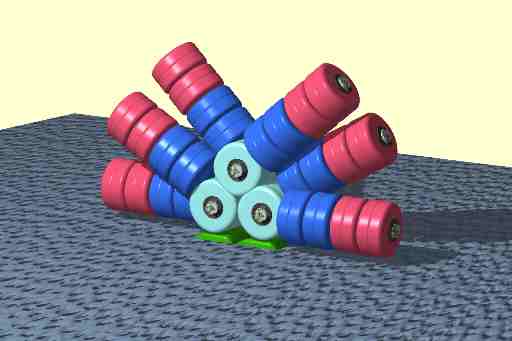Phycobiliprotein on:
[Wikipedia]
[Google]
[Amazon]
Phycobiliproteins are water-soluble 
fluorimetric microplate assays
FISH and multicolor detection. They are under development for use in
protein
Proteins are large biomolecules and macromolecules that comprise one or more long chains of amino acid residues. Proteins perform a vast array of functions within organisms, including catalysing metabolic reactions, DNA replication, respo ...
s present in cyanobacteria
Cyanobacteria (), also known as Cyanophyta, are a phylum of gram-negative bacteria that obtain energy via photosynthesis. The name ''cyanobacteria'' refers to their color (), which similarly forms the basis of cyanobacteria's common name, blu ...
and certain algae (rhodophyte
Red algae, or Rhodophyta (, ; ), are one of the oldest groups of eukaryotic algae. The Rhodophyta also comprises one of the largest phyla of algae, containing over 7,000 currently recognized species with taxonomic revisions ongoing. The majority ...
s, cryptomonad
The cryptomonads (or cryptophytes) are a group of algae, most of which have plastids. They are common in freshwater, and also occur in marine and brackish habitats. Each cell is around 10–50 μm in size and flattened in shape, with an anteri ...
s, glaucocystophytes
The glaucophytes, also known as glaucocystophytes or glaucocystids, are a small group of unicellular algae found in freshwater and moist terrestrial environments, less common today than they were during the Proterozoic. The stated number of spe ...
). They capture light energy, which is then passed on to chlorophyll
Chlorophyll (also chlorophyl) is any of several related green pigments found in cyanobacteria and in the chloroplasts of algae and plants. Its name is derived from the Greek words , ("pale green") and , ("leaf"). Chlorophyll allow plants to a ...
s during photosynthesis
Photosynthesis is a process used by plants and other organisms to convert light energy into chemical energy that, through cellular respiration, can later be released to fuel the organism's activities. Some of this chemical energy is stored i ...
. Phycobiliproteins are formed of a complex between proteins and covalent
A covalent bond is a chemical bond that involves the sharing of electrons to form electron pairs between atoms. These electron pairs are known as shared pairs or bonding pairs. The stable balance of attractive and repulsive forces between atoms ...
ly bound phycobilins that act as chromophores (the light-capturing part). They are most important constituents of the phycobilisome
Phycobilisomes are light harvesting antennae of photosystem II in cyanobacteria, red algae and glaucophytes. It was lost in the plastids of green algae / plants (chloroplasts).
General structure
Phycobilisomes are protein complexes (up to 6 ...
s.

Major phycobiliproteins
Characteristics
Phycobiliproteins demonstrate superior fluorescent properties compared to small organic fluorophores, especially when high sensitivity or multicolor detection required : * Broad and high absorption of light suits many light sources * Very intense emission of light: 10-20 times brighter than small organic fluorophores * Relative large Stokes shift gives low background, and allows multicolor detections. * Excitation and emission spectra do not overlap compared to conventional organic dyes. * Can be used in tandem (simultaneous use by FRET) with conventional chromophores (i.e. PE and FITC, or APC and SR101 with the same light source). * Longer fluorescence retention period. * High water solubilityApplications
Phycobiliproteins allow very high detection sensitivity, and can be used in various fluorescence based techniquefluorimetric microplate assays
FISH and multicolor detection. They are under development for use in
artificial photosynthesis
Artificial photosynthesis is a chemical process that biomimics the natural process of photosynthesis to convert sunlight, water, and carbon dioxide into carbohydrates and oxygen. The term artificial photosynthesis is commonly used to refer to ...
, limited by the relatively low conversion efficiency of 4-5%.
References